 Technology peripherals
Technology peripherals
 AI
AI
 In-depth understanding of charts: ChartLlama, open source chart behemoths such as Tencent and Nanyang Polytechnic
In-depth understanding of charts: ChartLlama, open source chart behemoths such as Tencent and Nanyang Polytechnic
In-depth understanding of charts: ChartLlama, open source chart behemoths such as Tencent and Nanyang Polytechnic
In the field of image understanding, multi-modal large models have fully demonstrated their excellent performance. However, there is still room for improvement in existing multimodal models for diagram understanding and generation tasks that are often handled in work.
Although the current state-of-the-art models in the field of graph understanding perform well on simple test sets, they are unable to handle more complex question and answer tasks due to their lack of language understanding and output capabilities. Task. On the other hand, the performance of multi-modal large models trained based on large language models is also unsatisfactory, mainly due to their lack of training samples for graphs. These problems have seriously restricted the continuous progress of multi-modal models in chart understanding and generation tasks
Recently, Tencent, Nanyang Technological University and Southeast University proposed ChartLlama. The research team created a high-quality graph dataset and trained a multi-modal large-scale language model focused on graph understanding and generation tasks. ChartLlama combines multiple functions such as language processing and chart generation to provide a powerful research tool for scientific researchers and related professionals.

Paper address: https://arxiv.org/abs/2311.16483
Home page address: https://tingxueronghua.github.io/ChartLlama/
The ChartLlama team designed a clever diversified data collection strategy, using GPT-4 to generate data with specific themes, distributions and trends of data to ensure the diversity of the data set. The team combined open source plotting libraries with the programming capabilities of GPT-4 to write precise charting code to produce accurate graphical data representations. In addition, the team also used GPT-4 to describe the chart content and generate question and answer pairs, and generated rich and diverse training samples for each chart to ensure that the trained model can fully understand the chart
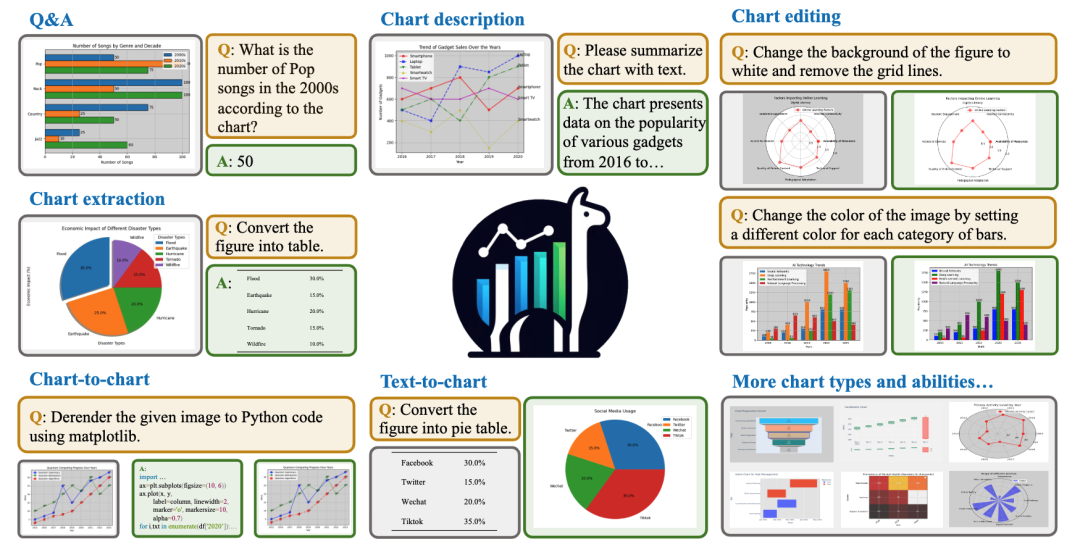
In the field of chart understanding, traditional models can only complete some simple questions, such as reading numbers and other simple question and answer tasks, and cannot answer more complex questions. These models have difficulty following long instructions and often make errors in questions and answers involving mathematical operations. In contrast, ChartLlama can effectively avoid these problems. The specific comparison is as follows:
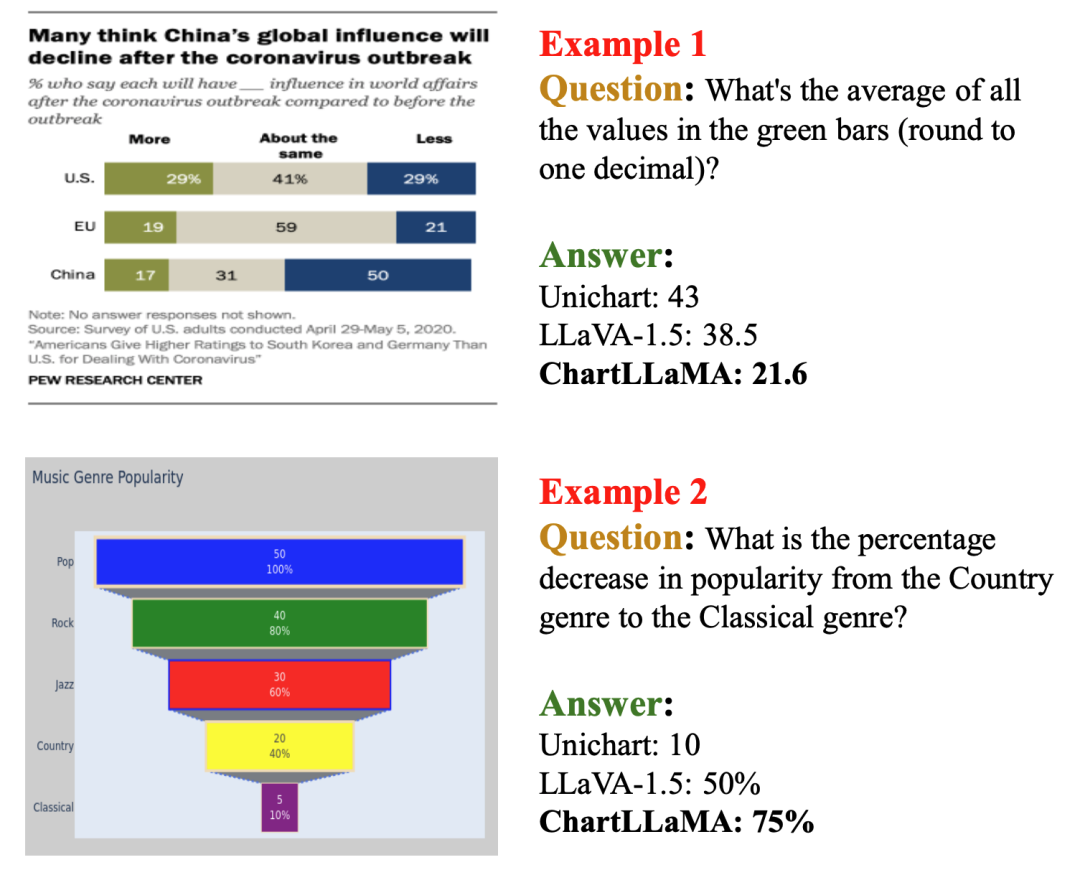
In addition to traditional tasks, the research team also defined several new tasks, including three tasks involving chart generation. The paper provides relevant examples:
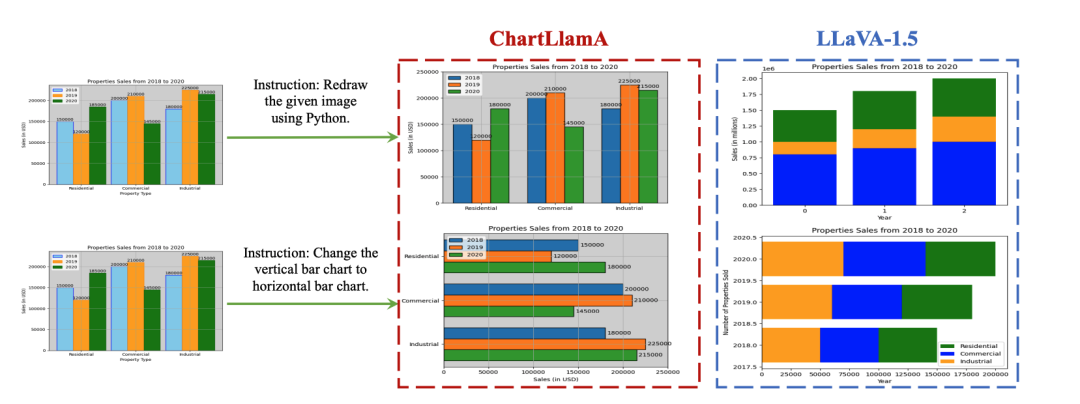 Given a chart and instructions, examples of chart reconstruction and chart editing
Given a chart and instructions, examples of chart reconstruction and chart editing
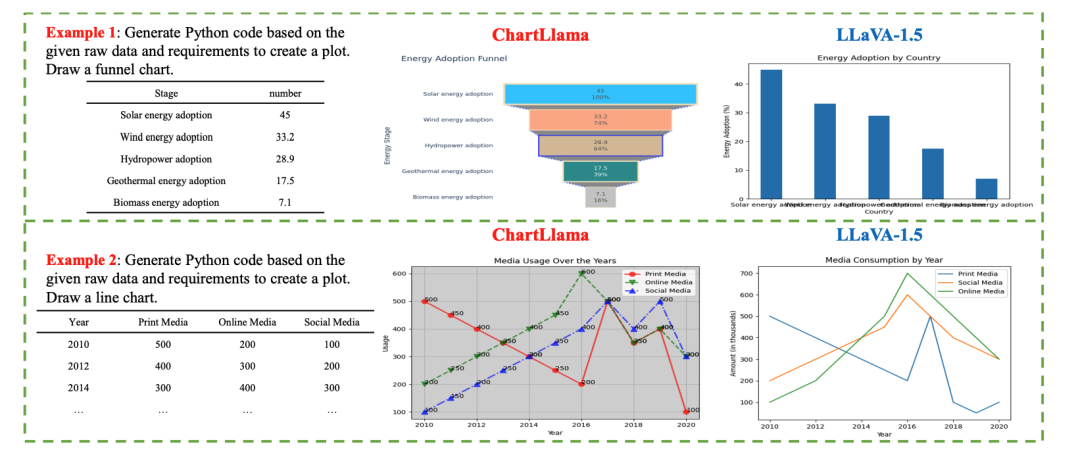
The process of generating chart examples is based on instructions and raw data
ChartLlama performs well on various benchmark data sets, reaching the state-of-the-art level, And the amount of training data required is also smaller. It adopts a flexible data generation and collection method, greatly expands the chart types and task types in chart understanding and generation tasks, and promotes the development of the field
Method Overview
ChartLlama has designed a flexible data collection method that leverages the powerful language and programming capabilities of GPT-4 to create rich multi-modal chart datasets.

ChartLlama’s data collection consists of three main phases:
- Chart data generation: ChartLlama not only collects data from traditional data sources, but also leverages the power of GPT-4 to generate synthetic data. GPT-4 is guided to produce diverse and balanced chart data by providing specific features such as topics, distributions, and trends. Since the generated data contains known data distribution characteristics, this makes the construction of instruction data more flexible and diverse.
- Chart generation: Next, use the powerful programming capabilities of GPT-4 and use open source libraries (such as Matplotlib) to write charts based on the generated data and function documents. Drawing scripts produced a series of carefully rendered diagrams. Since the drawing of charts is entirely based on open source tools, this algorithm can generate more types of charts for training. Compared with existing data sets, such as ChatQA, which only supports three chart types, the data set built by ChartLlama supports up to 10 chart types and can be arbitrarily expanded.
-
Instruction data generation: In addition to chart rendering, ChartLlama further uses GPT-4 to describe chart content and construct a variety of question and answer data to ensure training A proven model can fully understand the graph. This comprehensive instruction-adapted corpus incorporates narrative text, question-answer pairs, and source or modified code for diagrams. Past data sets only support 1-3 chart understanding tasks, while ChartLlama supports up to 10 chart understanding and generation tasks, which can better help train large graphics and text models to understand the information in icons
Using the above steps, ChartLlama has built a dataset containing multiple tasks and multiple chart types. The proportions of different types of tasks and charts in the total data set are as follows:
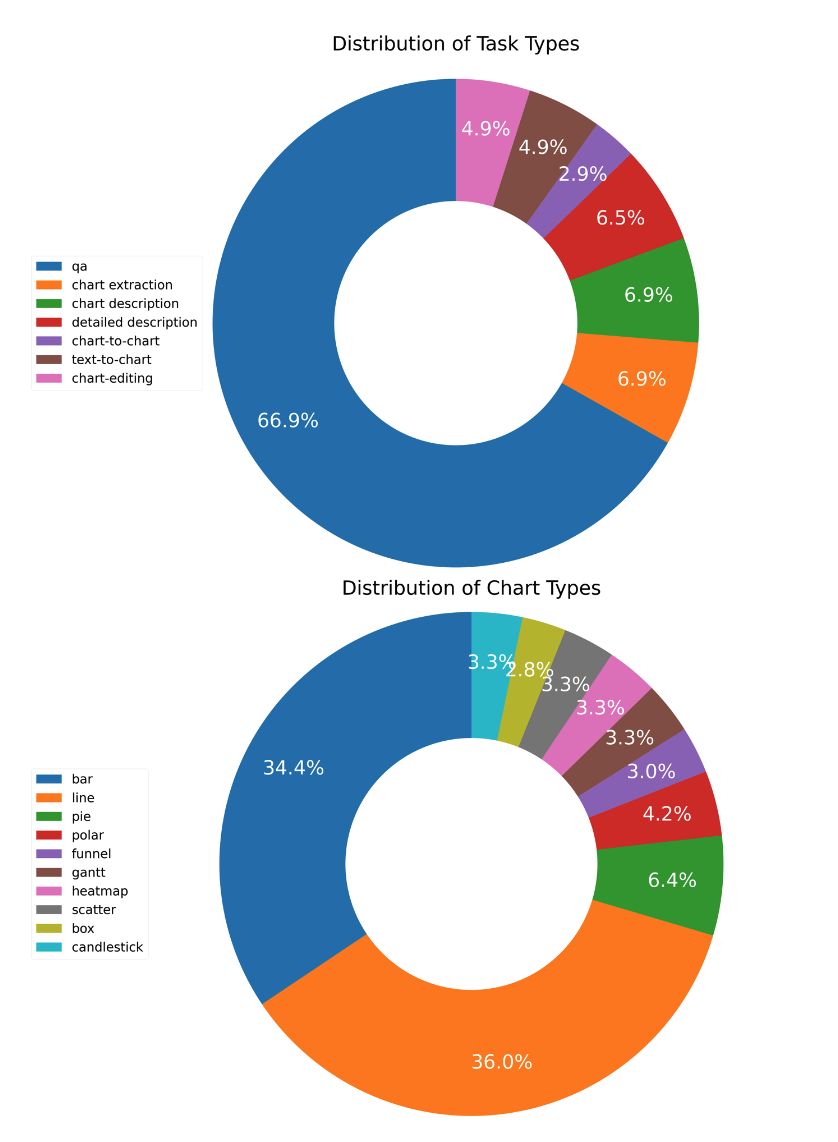
Please refer to the original paper for more detailed instructions and instructions
Experimental results
Whether it is a traditional task or a new task, ChartLlama has demonstrated the most superior performance. Traditional tasks include chart question-and-answer, chart summary, and structured data extraction of charts. Comparing ChartLlama with previous state-of-the-art models, the results are shown below:

The researchers also evaluated ChartLlama’s unique task capabilities, including generating Chart code, summarize chart and edit chart. They also created a test set for the corresponding task and compared it with LLaVA-1.5, the most powerful open source graphic and text model currently. Here are the results:

The research team tested ChartLlama’s question-answer accuracy on a variety of different types of charts and compared it with previous SOTA Model Unichart was compared with the proposed baseline model, and the results are as follows:

Overall, ChartLlama not only pushes the boundaries of multi-modal learning , and also provides a more accurate and efficient tool for chart understanding and generation. Whether in academic writing or corporate presentations, ChartLlama will make understanding and creating charts more intuitive and efficient, taking an important step forward in generating and interpreting complex visual data.
Interested readers can go to the original text of the paper to get more research content
The above is the detailed content of In-depth understanding of charts: ChartLlama, open source chart behemoths such as Tencent and Nanyang Polytechnic. For more information, please follow other related articles on the PHP Chinese website!

Hot AI Tools

Undresser.AI Undress
AI-powered app for creating realistic nude photos

AI Clothes Remover
Online AI tool for removing clothes from photos.

Undress AI Tool
Undress images for free

Clothoff.io
AI clothes remover

Video Face Swap
Swap faces in any video effortlessly with our completely free AI face swap tool!

Hot Article

Hot Tools

Notepad++7.3.1
Easy-to-use and free code editor

SublimeText3 Chinese version
Chinese version, very easy to use

Zend Studio 13.0.1
Powerful PHP integrated development environment

Dreamweaver CS6
Visual web development tools

SublimeText3 Mac version
God-level code editing software (SublimeText3)

Hot Topics
 The world's most powerful open source MoE model is here, with Chinese capabilities comparable to GPT-4, and the price is only nearly one percent of GPT-4-Turbo
May 07, 2024 pm 04:13 PM
The world's most powerful open source MoE model is here, with Chinese capabilities comparable to GPT-4, and the price is only nearly one percent of GPT-4-Turbo
May 07, 2024 pm 04:13 PM
Imagine an artificial intelligence model that not only has the ability to surpass traditional computing, but also achieves more efficient performance at a lower cost. This is not science fiction, DeepSeek-V2[1], the world’s most powerful open source MoE model is here. DeepSeek-V2 is a powerful mixture of experts (MoE) language model with the characteristics of economical training and efficient inference. It consists of 236B parameters, 21B of which are used to activate each marker. Compared with DeepSeek67B, DeepSeek-V2 has stronger performance, while saving 42.5% of training costs, reducing KV cache by 93.3%, and increasing the maximum generation throughput to 5.76 times. DeepSeek is a company exploring general artificial intelligence
 AI subverts mathematical research! Fields Medal winner and Chinese-American mathematician led 11 top-ranked papers | Liked by Terence Tao
Apr 09, 2024 am 11:52 AM
AI subverts mathematical research! Fields Medal winner and Chinese-American mathematician led 11 top-ranked papers | Liked by Terence Tao
Apr 09, 2024 am 11:52 AM
AI is indeed changing mathematics. Recently, Tao Zhexuan, who has been paying close attention to this issue, forwarded the latest issue of "Bulletin of the American Mathematical Society" (Bulletin of the American Mathematical Society). Focusing on the topic "Will machines change mathematics?", many mathematicians expressed their opinions. The whole process was full of sparks, hardcore and exciting. The author has a strong lineup, including Fields Medal winner Akshay Venkatesh, Chinese mathematician Zheng Lejun, NYU computer scientist Ernest Davis and many other well-known scholars in the industry. The world of AI has changed dramatically. You know, many of these articles were submitted a year ago.
 Google is ecstatic: JAX performance surpasses Pytorch and TensorFlow! It may become the fastest choice for GPU inference training
Apr 01, 2024 pm 07:46 PM
Google is ecstatic: JAX performance surpasses Pytorch and TensorFlow! It may become the fastest choice for GPU inference training
Apr 01, 2024 pm 07:46 PM
The performance of JAX, promoted by Google, has surpassed that of Pytorch and TensorFlow in recent benchmark tests, ranking first in 7 indicators. And the test was not done on the TPU with the best JAX performance. Although among developers, Pytorch is still more popular than Tensorflow. But in the future, perhaps more large models will be trained and run based on the JAX platform. Models Recently, the Keras team benchmarked three backends (TensorFlow, JAX, PyTorch) with the native PyTorch implementation and Keras2 with TensorFlow. First, they select a set of mainstream
 Hello, electric Atlas! Boston Dynamics robot comes back to life, 180-degree weird moves scare Musk
Apr 18, 2024 pm 07:58 PM
Hello, electric Atlas! Boston Dynamics robot comes back to life, 180-degree weird moves scare Musk
Apr 18, 2024 pm 07:58 PM
Boston Dynamics Atlas officially enters the era of electric robots! Yesterday, the hydraulic Atlas just "tearfully" withdrew from the stage of history. Today, Boston Dynamics announced that the electric Atlas is on the job. It seems that in the field of commercial humanoid robots, Boston Dynamics is determined to compete with Tesla. After the new video was released, it had already been viewed by more than one million people in just ten hours. The old people leave and new roles appear. This is a historical necessity. There is no doubt that this year is the explosive year of humanoid robots. Netizens commented: The advancement of robots has made this year's opening ceremony look like a human, and the degree of freedom is far greater than that of humans. But is this really not a horror movie? At the beginning of the video, Atlas is lying calmly on the ground, seemingly on his back. What follows is jaw-dropping
 KAN, which replaces MLP, has been extended to convolution by open source projects
Jun 01, 2024 pm 10:03 PM
KAN, which replaces MLP, has been extended to convolution by open source projects
Jun 01, 2024 pm 10:03 PM
Earlier this month, researchers from MIT and other institutions proposed a very promising alternative to MLP - KAN. KAN outperforms MLP in terms of accuracy and interpretability. And it can outperform MLP running with a larger number of parameters with a very small number of parameters. For example, the authors stated that they used KAN to reproduce DeepMind's results with a smaller network and a higher degree of automation. Specifically, DeepMind's MLP has about 300,000 parameters, while KAN only has about 200 parameters. KAN has a strong mathematical foundation like MLP. MLP is based on the universal approximation theorem, while KAN is based on the Kolmogorov-Arnold representation theorem. As shown in the figure below, KAN has
 Recommended: Excellent JS open source face detection and recognition project
Apr 03, 2024 am 11:55 AM
Recommended: Excellent JS open source face detection and recognition project
Apr 03, 2024 am 11:55 AM
Face detection and recognition technology is already a relatively mature and widely used technology. Currently, the most widely used Internet application language is JS. Implementing face detection and recognition on the Web front-end has advantages and disadvantages compared to back-end face recognition. Advantages include reducing network interaction and real-time recognition, which greatly shortens user waiting time and improves user experience; disadvantages include: being limited by model size, the accuracy is also limited. How to use js to implement face detection on the web? In order to implement face recognition on the Web, you need to be familiar with related programming languages and technologies, such as JavaScript, HTML, CSS, WebRTC, etc. At the same time, you also need to master relevant computer vision and artificial intelligence technologies. It is worth noting that due to the design of the Web side
 Tesla robots work in factories, Musk: The degree of freedom of hands will reach 22 this year!
May 06, 2024 pm 04:13 PM
Tesla robots work in factories, Musk: The degree of freedom of hands will reach 22 this year!
May 06, 2024 pm 04:13 PM
The latest video of Tesla's robot Optimus is released, and it can already work in the factory. At normal speed, it sorts batteries (Tesla's 4680 batteries) like this: The official also released what it looks like at 20x speed - on a small "workstation", picking and picking and picking: This time it is released One of the highlights of the video is that Optimus completes this work in the factory, completely autonomously, without human intervention throughout the process. And from the perspective of Optimus, it can also pick up and place the crooked battery, focusing on automatic error correction: Regarding Optimus's hand, NVIDIA scientist Jim Fan gave a high evaluation: Optimus's hand is the world's five-fingered robot. One of the most dexterous. Its hands are not only tactile
 FisheyeDetNet: the first target detection algorithm based on fisheye camera
Apr 26, 2024 am 11:37 AM
FisheyeDetNet: the first target detection algorithm based on fisheye camera
Apr 26, 2024 am 11:37 AM
Target detection is a relatively mature problem in autonomous driving systems, among which pedestrian detection is one of the earliest algorithms to be deployed. Very comprehensive research has been carried out in most papers. However, distance perception using fisheye cameras for surround view is relatively less studied. Due to large radial distortion, standard bounding box representation is difficult to implement in fisheye cameras. To alleviate the above description, we explore extended bounding box, ellipse, and general polygon designs into polar/angular representations and define an instance segmentation mIOU metric to analyze these representations. The proposed model fisheyeDetNet with polygonal shape outperforms other models and simultaneously achieves 49.5% mAP on the Valeo fisheye camera dataset for autonomous driving





